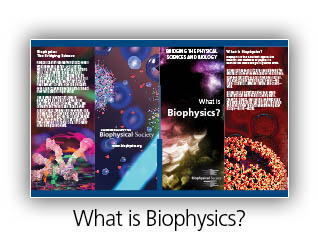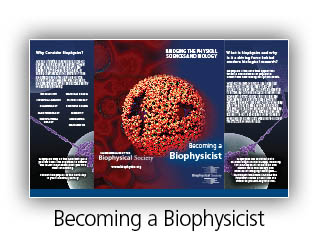Call for Lesson Plans & Experiments
For Biophysics Week, the Biophysical Society is proud to feature Lesson Plans and Experiments targeted towards K-12 and undergraduate classrooms.
Have you or your students created a lesson plan, experiment, or educational video that you’d like to have featured during Biophysics Week? Sharing resources is a valuable way to support the biophysics community! All submissions will be reviewed by members of the Education Committee and selected pieces will be highlighted during Biophysics Week.
Need inspiration? Check out these featured Lesson Plans and Experiments: https://www.biophysics.org/biophysics-basics#/
For Lesson Plans and Experiments, please include the following information:
- Author(s) Name & Email
- Lesson Plan Title
- Available Languages (in which languages is the lesson plan available)
- Background
- Objectives and Grade Level
- Materials and Equipment
- Procedure
- Notes
- Figures
- Supplemental Files and Videos
- References
- Author Acknowledgements
To contribute, submit your materials to Ethan Rogers-Yosebashvili at [email protected]. Contributors will receive a free Biophysics Week t-shirt!
Submit a Classical Lay Summary
For Biophysics Week, the Society is proud to feature short summaries of classical biophysics studies that are contributed by the community and accessible to scientists and non-scientists alike.
Help us celebrate Biophysics Week by contributing your own Classical Lay Summary! Your summary will be reviewed and edited by members of the Early Careers Committee and selected pieces will be featured on the BPS Blog and social media. Contributors will also receive a free Biophysics Week t-shirt.
To contribute a lay summary, submit your piece and a related graphic to Ethan Rogers-Yosebashvili at [email protected].
Need inspiration? Check out these classical lay summaries:
For general tips on writing a lay summary, read Top 9 Tips on How to Write a Great Lay Summary.
Communicating Science Video Clip Series
BPS members Chris Yip and Samantha Yammine have put together a series of short videos on cell biophysics topics.
Microscopic cells that make up our bodies are fascinating, and these videos are intended to share their wonder Each day during Biophysics Week, we will be sharing a new explainer videos of a concepts in cell biophysics.
What is a Cell and How Small is It, Anyway?? Check out this quick explainer video we made to kick off #BiophysicsWeek!
One of the most important and mysterious parts of your life happened before you were born. It’s called “gastrulation,” and was when your cells migrated all over thanks to chemical cues and physical forces. Gastrulation turns the developing organism from a single sheet of cells to a 3D structure with multiple layers. The different layers made through gastrulation are the blueprints for every organ in your body today.
Human brains have more trillions of connections than we’ve been able to count, so scientists all over the globe study the simple but powerful nervous system in the microscopic worm C elegans instead. Watch as its 302 neurons develop and form about 7000 connections all throughout the head and body. Because of detailed maps like this, C elegans, has been instrumental to our understanding of genetics, development, aging, cell death, and movement in many organisms.
This is the blood vessel network of a 2 day old zebrafish. Blood is critical to organisms as they develop because it delivers the nutrients and oxygen the body’s cells need in order to grow. Blood rushes through vessels to reach cells all over the body at speeds ranging from 1 µm/s to 1 mm/s. The network of blood vessels are made of many different cell types, each with a special role to keep our pipes strong but flexible to changing forces of the blood flow that’s critical to our survival.
New cells are being born all throughout your body every single day. Only some cells have the ability to birth new cells, doubling their DNA and being ripped in two by either end to do so. This process of cell division is usually tightly controlled, but when a few of the breaks get lifted by genetic mutation, cells may start dividing too much and form a tumour. Understanding the basic biology of how cells normally divide and stop themselves from dividing is therefore key to being able to instruct cells to step back on their breaks.
Implicit or unconscious bias is a fascinating, and sometimes confusing topic that is highly relevant given the increasingly polarized political climate of today. The near constant drumbeat of events and statements that may be perceived to be motivated by bias can be overwhelming, and, paradoxically, can make it difficult for well-intentioned people to address the role their own biases may play in perpetuating unfair systems and practices. In this video lecture, Keith B. Maddox, Associate Professor of Psychology at Tufts University, provides a thought provoking discussion looking at the science surrounding these issues and offers advice on confronting and overcoming bias.
Over the years, the Biophysical Society has received numerous requests for advice on starting a biophysics major, or program, at the undergraduate level. We are pleased to now offer Suggested Guidelines for Starting an Undergraduate Biophysics Program! The purpose of these guidelines are to provide guidance to educators looking to get started in developing curriculum and expanding the biophysics offerings at their institutions, along with advice and ideas for employing effective pedagogical methods, sustaining a program, professional development, and finding additional resources to stay current within the field.
In celebration of Biophysics Week, and to help introduce simple biophysics concepts to a younger audience, the Society launched BASICS: Biophysics - A Step-by-Step Introduction to Concepts for Students, a new series of lesson plans designed for high school teachers and students. The first plans in this series introduce students to the concepts of Diffusion, Viscosity, Elasticity, and Experimental Error. The Society is pleased to offer three of these lesson plans in Spanish as well as English. Please see below for our Statement of Use policy. We hope that these plans excite both teachers and students, and inspire students to consider biophysics as a course of study as they begin their college careers.
Download the following brochures:

